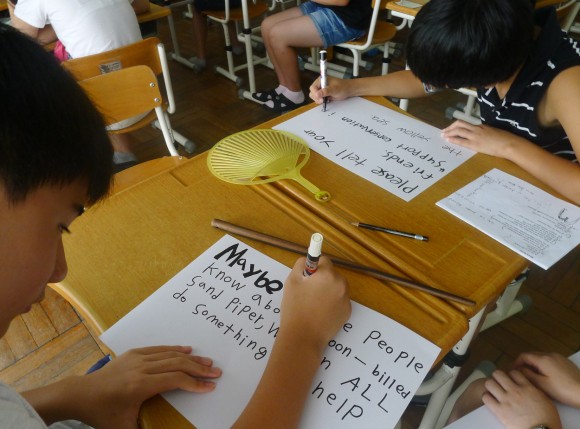Posted by Jason Loghry, August 4
This week at Obang Elementary School in Gimhae we enjoyed a four day camp learning about birds, birding, and conservation.
Our students learned why so many people around the world enjoy birds and birding. We studied some birding basics starting with how to describe what we see.
Students were given hand-made field journals and asked to examine posters of different species in different habitat and write a short description. These species included some of the threatened species found in this region. It was a chance for them to practice using a second language (English) and explore their creative side with nature drawing.
We talked a lot about migration, flyways, and the boundless journey of many short distant and long distant migrants. Students focused on species of the East Asian-Australasian Flyway and learned about many of the threats they face in the Yellow Sea region.
On days three and four, we dedicated our time to our favorite species, the critically endangered Spoon-billed Sandpiper. Knowing this species has reached this critical point, all of us are inspired to help in some way. Some students designed postcards with some fantastic drawings of Spoonies and wrote notes with one main message, Together, Let’s Save Spoonies.
These postcards will be sent to students of different countries on the flyway. We’re hoping to start a correspondence about conservation issues so maybe later we can team up and do some projects to help endangered species, like Spoon-billed Sandpiper. (Very special thanks to Ms Vivian Fu of the Hong Kong Birdwatching Society for helping to make this happen!)

 Postcards were written carefully in both English and Korean.
Postcards were written carefully in both English and Korean.
Some students teamed up and recorded a short video that we hope can later be used to help promote awareness for saving Spoonies and tidal flats in the ROK.

 They wrote a script for their recordings with a continued theme of Together, Let’s Save Spoonies.
They wrote a script for their recordings with a continued theme of Together, Let’s Save Spoonies.
And finally, a very special note written by Kong Sung Won (Grade 6) about our camp and conservation:
In Korean:
“3일 동안 새에 대해 배웠고, 그렇게 많이 알아가지는 못했지만, 기억에 남는 새들은 꽤 많은 거 같다.
넓적부리도요, 저어새, 호사비오리, 바다제비등…
저어새는 생김새가 조금 특이하고, 강렬해서 기억에 남았던 것 같다.
호사비오리는 처음에 들었을 때 허수아비 오리인줄 알고 신기한 이름이네 했었는데
그림을 그릴 때 보니 ‘호사비’ 오리여서 살짝 당황했었다.
생김새는 뭔가 무서우면서 귀여운 인상이었던 것 같다.
바다제비 생김새는 기억이 잘 나지 않지만 새 관찰일지를 기록하면서 제일 먼저 기록한 새라서 그런지
기억에 가장 남았던 것 같다.
넓적 부리도요…… 5학년 영어 캠프 때때 선생님이 준비하신 활동을 통해서 알게 된 내가 좋아하는 새 중 한 종류이다.
그리고 6학년이 되어서 넓적부리도요에 대해 다시 들어보니 뭔가 지켜주고 싶다.
우리가 어떻게 해야 할까? 라는 생각이 스쳐지나 갔다.
넓적부리도요는 2008에 200쌍보다 조금 더 많았으나, 2013년에는 100쌍보다 더 작은 개체수로 줄어든 만큼
사람들로부터 많은 고통과 아픔을 받고 있다.
이 새를, 넓적부리도요를 지키기 위해선 어떤 노력을 해야 하는 걸까?
돈을 모으는 것만으로 될까? 돈으로 아무리 많은 단체를 만들고 많은 장비를 만든다 해도 사냥꾼들은 멈추지 않을 것이고,
모인 돈으로 새들이 생활하기 좋은 환경으로 바꾼다고 해도, 계속된 개발로 인해 파괴되는 자연을 좋은 환경으로(새들이 살기 좋은 환경) 만들어 지속시키기엔 한계가 있다.
그러니 우리에겐 현실적인, 우리가 지속적으로 할 수 있는 방법을 찾아야 한다.
예를 들자면 새가 많이 모이는 갯벌지역과 같은 곳의 개발을 최소화하고, 넓적부리도요를 포함하여 생존이 불확실한 새들이
처한 환경을 뉴스를 통해 더 많은 사람들에게 도움을 요청하고 새를 보호하자고 하는 것이다.
사소한 방법이라도 계속 생각만 하고 있지 말고, 귀찮다고 놀지 말고 실행하고 실천하여 조금이라도
아주 작은 목숨이라도 보존했으면 좋겠다.”
In English:
“For 3 days I have learned about birds. Still, I don’t know about birds perfectly. But I remember many birds like Spoon-billed Sandpiper, Scaly-sided Merganser, Swinhoe’s Storm-petrel, etc.
The most memorable bird is the Black-faced Spoonbill, which is a bit unique and impressive compared to other birds. When I first heard the Korean name of Scaly-sided Merganser, “Hosabi Ori”, I thought it was pronounced “Hoswabi”, which means scarecrow. Then I realized it was Hosabi, so I was a little embarrassed. This bird seems a little scary but cute at the same time. I don’t exactly remember the appearance of Swinhoe’s Storm-petrel, however I remember most of the birds from writing in our field journals.
Spoon-billed Sandpiper was one of my favorite birds to learn about last year at camp. Now, in the sixth grade, I’d like to protect the Spoon-billed Sandpiper. When I joined this English camp again, I wondered what we would do. This year, I learned Spoon-billed Sandpipers have decreased from more than 200 pairs in 2008 to fewer than 100 pairs in 2013. Because of people, this has happened.
What will we do to protect the Spoon-billed Sandpiper? Even if we invest a lot of money into organisations, I feel doubtful we can stop hunters from hunting completely. There are limitations to maintaining a good environment because of continuous development. Now, we need to find a realistic approach. For example, we need to minimize development on tidal flats, which are of vital importance for many birds, like the Spoon-billed Sandpiper. We have to appeal to people and increase awareness through news. We can’t only do minimal things like acknowledging the problem, we must act to protect birds. We should help conserve the survival of even the smallest birds.”




Amazing work, Mr. Loghry. If you don’t mind, I would like to share this with family and friends.